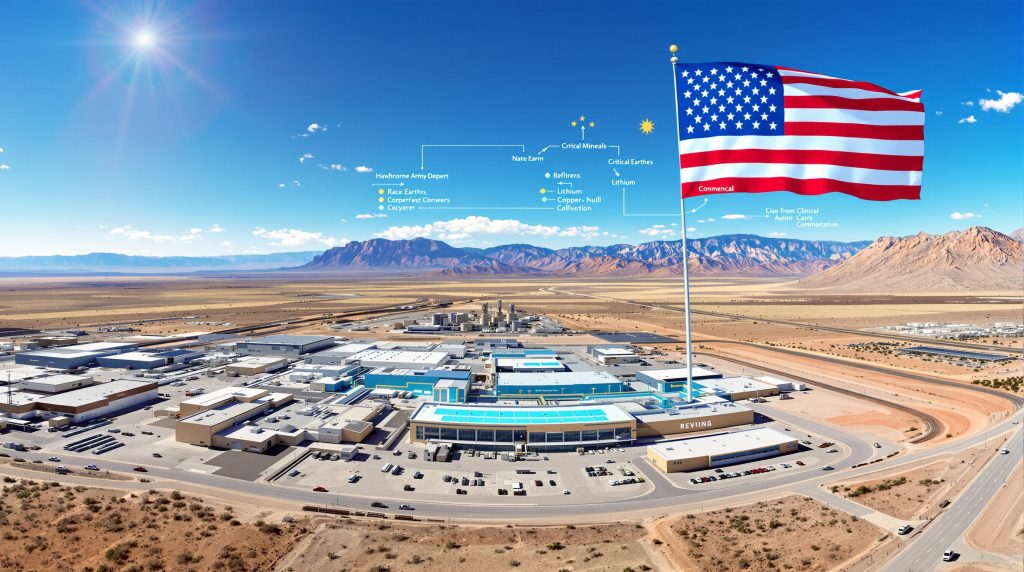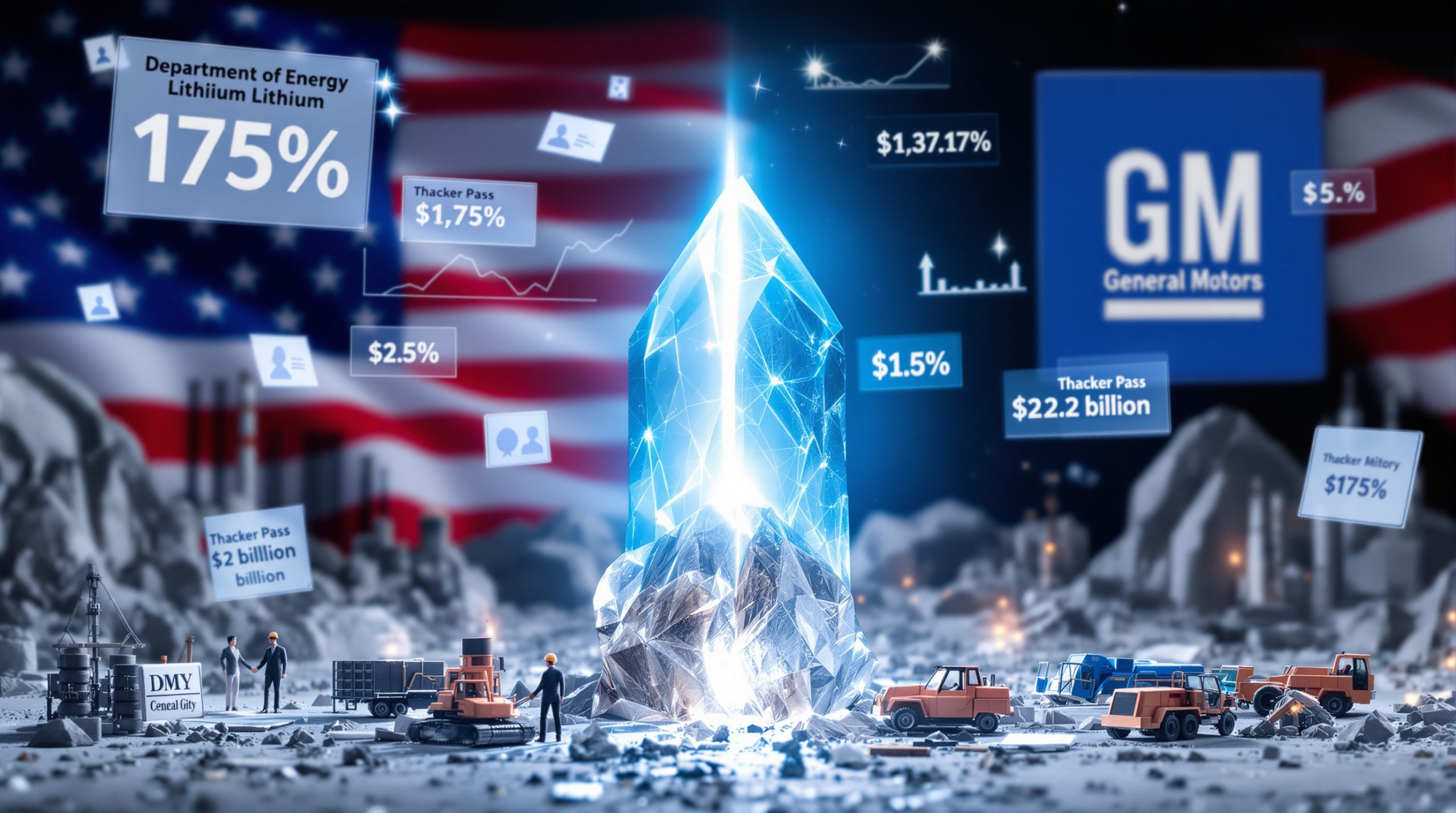What is the US Strategic Minerals Reserve in Nevada?
The United States' first Strategic Minerals Reserve (SMR) represents a fundamental shift in how America secures critical minerals. Headquartered at Hawthorne Army Depot in Nevada, this initiative moves beyond traditional stockpiling to create an integrated ecosystem for mineral security. The reserve functions as a comprehensive platform that combines secure storage with refining capabilities, recycling operations, and ethical sourcing protocols.
Unlike its Cold War predecessor, the National Defense Stockpile, this modern reserve is designed as a "strategic capability" rather than simply a warehouse of materials. As M2i Global, the company driving the initiative, explains, the SMR aims to "blend secure storage, refining, recycling and ethical sourcing to deliver a durable advantage across defense and energy supply chains." This approach reflects a recognition that 21st-century mineral security requires more than passive accumulation of raw materials.
The Evolution from Stockpile to Strategic Platform
The SMR represents a paradigm shift in mineral security strategy—moving from what M2i Global describes as a "platform, not a pile" approach. This distinction is crucial for understanding the reserve's potential impact on supply chains. Rather than simply warehousing materials until needed, the SMR actively manages, processes, and recycles critical minerals to maintain strategic readiness.
This evolution addresses longstanding criticisms of traditional stockpiling approaches, which often resulted in outdated inventories, high maintenance costs, and minimal industry engagement. By incorporating active inventory management, the SMR can respond dynamically to changing technological needs and supply conditions.
The Strategic Significance of Hawthorne Army Depot
The selection of Hawthorne Army Depot as the SMR's headquarters leverages existing security infrastructure at what's described as "the world's largest ammunition storage facility." This location offers several distinct advantages that would be difficult to replicate at a new site:
- Pre-existing security perimeter and protocols designed for sensitive materials
- Established rail access for efficient transportation
- Remote location providing natural security buffer
- Existing environmental permits for industrial activities
- Federal land designation simplifying regulatory approvals
These attributes significantly reduce the startup timeline compared to establishing a completely new facility, allowing the SMR to become operational more quickly in response to supply chain concerns.
Why is the US Establishing a Strategic Minerals Reserve Now?
The timing of the SMR's creation directly responds to growing concerns about foreign dominance in critical mineral processing. The Fastmarkets report highlights that "China dominates gallium, graphite and rare earths refining, and isn't shy about using export restrictions as leverage." This vulnerability has become increasingly concerning as these materials play crucial roles in both defense systems and clean energy technologies.
Recent global supply chain disruptions have underscored the risks of overreliance on concentrated supply sources. The COVID-19 pandemic, shipping bottlenecks, and geopolitical tensions have all demonstrated how quickly critical supply chains can be compromised, creating a renewed urgency for domestic supply chain resilience.
Addressing Critical Supply Chain Vulnerabilities
The establishment of the SMR represents a strategic response to multiple supply chain vulnerabilities:
- Single-source dependencies: Many critical minerals energy transition are sourced predominantly from a single country or region
- Processing bottlenecks: Even when raw materials are available, refining capacity is often concentrated overseas
- Export restrictions: Foreign suppliers have demonstrated willingness to leverage mineral exports for geopolitical advantage
- Market volatility: Price fluctuations and supply uncertainty complicate planning for manufacturers and defense contractors
- Environmental and social governance concerns: Many critical mineral supply chains lack transparency on environmental and labor practices
By creating domestic capabilities across the entire supply chain—from processing to recycling—the SMR aims to mitigate these vulnerabilities while establishing more resilient supply networks.
Policy Foundations and Funding
The SMR follows the January 2025 "Unleashing American Energy" executive order on minerals, which declared a national energy emergency. This executive action directed federal agencies to accelerate mineral exploration, streamline permitting processes, and expand critical mineral processing capabilities within the United States.
The Department of Energy subsequently announced nearly $1 billion in funding for mining, refining, and recycling projects in August 2025, providing financial backing for the SMR initiative. This substantial investment signals the administration's commitment to addressing mineral security as a national priority.
This policy framework creates the necessary conditions for the SMR's development by:
- Establishing mineral security as a national priority
- Allocating significant funding for implementation
- Directing agencies to streamline regulatory processes
- Creating incentives for private sector participation
- Setting clear objectives for domestic capability development
How Will the Strategic Minerals Reserve Transform US Mineral Security?
The SMR represents a transformative approach to mineral security that goes far beyond traditional stockpiling models. Rather than simply storing materials for emergency use, the reserve will actively participate in supply chains through processing, recycling, and strategic material management.
Beyond Traditional Stockpiling: A Multi-Function Approach
Unlike passive stockpiles that simply warehouse materials, the SMR is designed as an active operational entity. Its integrated capabilities include:
- Active inventory management: Rotating stocks to maintain relevance and quality
- Processing operations: Converting raw materials into usable forms
- Recycling facilities: Recovering critical minerals from end-of-life products
- Quality control systems: Ensuring materials meet industry specifications
- Market engagement: Potential to function as a "buyer of last resort" during market downturns
This multi-function approach allows the SMR to adapt to changing technology needs while maintaining strategic readiness. By incorporating battery recycling breakthrough technologies, the reserve can reduce dependence on new extraction while maximizing the value of materials already in circulation.
Public-Private Partnership Structure
M2i Global has structured the SMR as a public-private partnership that blends government security requirements with commercial operational efficiency. This hybrid approach allows for more flexible and responsive management than traditional government stockpiles while maintaining strategic alignment with national security objectives.
The company's structure spans "recycling, refining and defense contracting," creating an integrated operational model that can engage with both government and commercial supply chains. This flexibility allows the SMR to:
- Adapt quickly to changing market conditions
- Leverage private sector operational expertise
- Access commercial technologies and innovations
- Engage with industry standards and specifications
- Balance strategic and economic objectives
Which Critical Minerals Will the Reserve Prioritize?
The SMR will concentrate on materials designated as critical to both national security and the energy transition. While the complete list hasn't been officially published, the Fastmarkets report specifically mentions copper, gallium, and graphite among the priority materials.
Strategic Material Selection Criteria
The selection of materials for the SMR likely follows a strategic assessment of multiple factors:
- Supply risk: Materials with concentrated global production or processing
- Defense applications: Materials essential for military systems and platforms
- Energy transition importance: Materials required for renewable energy and electrification
- Domestic availability: Potential for increased domestic production or recycling
- Processing bottlenecks: Materials where refining capacity is a constraint
This multi-criteria approach ensures the SMR focuses on materials where strategic intervention can most effectively reduce supply chain vulnerabilities while supporting both defense and energy transition objectives.
Copper's Strategic Inclusion
Notably, copper has been included in the SMR's focus despite its historical absence from US critical minerals lists. As the Fastmarkets report notes, copper "is finally being recognized as indispensable for electrification, defense and the energy transition."
This recognition reflects a growing understanding of copper's crucial role in:
- Electrical infrastructure: Power transmission and distribution systems
- Renewable energy: Wind turbines, solar panels, and related equipment
- Electric vehicles: Motors, wiring, and charging infrastructure
- Defense systems: Electronics, communications, and weapons platforms
- Energy efficiency: Heat exchangers and high-efficiency motors
The inclusion of copper—a relatively abundant but strategically vital material—signals a more sophisticated understanding of supply chain vulnerabilities beyond simple material scarcity. Processing capacity, quality requirements, and demand growth are increasingly recognized as crucial factors in strategic mineral planning.
How Will the Strategic Minerals Reserve Impact Global Markets?
Unlike static stockpiles, the SMR's active management approach could influence market dynamics in several ways. Its potential to serve "as a buyer of last resort" and assist with "smoothing price volatility" suggests a more engaged role in mineral markets than traditional government reserves.
Market Stabilization Mechanisms
The SMR's active inventory management capabilities could provide several market stabilization functions:
- Counter-cyclical purchasing: Acquiring materials during market downturns to support producers
- Strategic releases: Providing materials during supply disruptions to prevent price spikes
- Quality benchmarking: Establishing material specifications and testing protocols
- Transparency improvements: Providing market data on available supplies and qualities
- Price discovery: Creating more liquid markets for specialized materials
These functions could help reduce the boom-bust cycles that have historically challenged critical mineral markets, creating more predictable conditions for both producers and consumers.
Reshaping International Mineral Trade
The creation of the SMR sends a clear signal that the United States intends to reduce dependency on fragile global supply chains. This initiative may influence how other nations approach their own mineral security strategies and could reshape international mineral trade relationships.
The reserve's establishment may accelerate several emerging trends in global mineral markets:
- Friendshoring: Preferential sourcing from allied nations
- Supply chain transparency: Increased emphasis on traceability and ethical sourcing
- Processing investment: New capacity development in Western nations
- Allied coordination: Harmonized approaches to mineral security among partner countries
- Standards alignment: Collaborative development of quality and sustainability standards
The SMR's potential to extend "through allied partnerships, given that the company already has ventures in Australia" suggests a multinational approach to mineral security that could significantly reshape global supply networks.
What Challenges Must the Strategic Minerals Reserve Overcome?
Despite its strategic importance, the SMR faces several significant implementation and operational challenges. These range from technical and regulatory hurdles to market engagement complexities and environmental considerations.
Implementation and Operational Hurdles
Establishing a comprehensive minerals reserve with processing capabilities involves numerous challenges:
- Regulatory compliance: Navigating complex permitting for processing operations
- Technical expertise: Developing specialized capabilities for diverse materials
- Market engagement: Determining appropriate purchase and release protocols
- Inventory management: Maintaining material quality and relevance over time
- Technology evolution: Adapting to changing material specifications and needs
- Funding continuity: Securing consistent resources across budget cycles
- Industry coordination: Aligning with existing private sector supply chains
Successfully addressing these challenges requires a carefully designed operational framework that balances strategic objectives with practical implementation considerations.
Environmental and Community Considerations
The development of domestic refining and processing capabilities will need to address environmental concerns through advanced technologies and sustainable practices. Processing operations typically involve:
- Water usage management and recycling systems
- Energy efficiency measures and renewable power integration
- Air quality control technologies
- Waste management and minimization protocols
- Noise and visual impact mitigation
Effectively addressing these considerations will be essential for maintaining community support and regulatory compliance while demonstrating that domestic processing can meet or exceed global environmental standards. Additionally, the industry must pursue mining sustainability transformation to ensure long-term viability and public acceptance.
Could the Strategic Minerals Reserve Expand Beyond Nevada?
The SMR's establishment at Hawthorne Army Depot appears to be just the first step in a potentially broader mineral security strategy. The Fastmarkets report notes that "M2i's modular structure…suggests the model could be replicated across the US or even overseas through allied partnerships."
Modular Expansion Potential
The modular approach described in the Fastmarkets report suggests the potential for "a networked system of strategic reserves rather than a single warehouse in Nevada." This distributed model could offer several advantages:
- Regional specialization: Different facilities focused on specific material groups
- Transportation optimization: Reduced shipping distances and costs
- Risk distribution: Preventing single-point vulnerabilities
- Local industry engagement: Alignment with regional mineral processing clusters
- Scalable implementation: Phased expansion based on demonstrated success
This networked approach would represent a significant evolution from traditional centralized stockpiles, creating a more resilient and adaptable mineral security system.
International Partnership Opportunities
M2i Global's existing ventures in Australia suggest potential for international expansion of the SMR model. Strategic partnerships with allied nations could create a coordinated approach to mineral security that leverages each country's comparative advantages.
Potential international dimensions include:
- Collaborative stockpiling: Shared reserves with allied access protocols
- Complementary specialization: Different nations focusing on specific materials
- Standards harmonization: Common quality and ethical sourcing requirements
- Technology sharing: Collaborative development of processing innovations
- Supply chain integration: Coordinated approach to material flows
Such international cooperation could significantly enhance the effectiveness of national mineral security initiatives while strengthening geopolitical alliances. Furthermore, exploring opportunities in regions like Greenland minerals geopolitical perspective could diversify supply sources.
FAQ: US Strategic Minerals Reserve
How does the Strategic Minerals Reserve differ from the National Defense Stockpile?
The SMR represents a significant evolution from the National Defense Stockpile established during the Cold War era. Key differences include:
- Active vs. passive management: The SMR actively processes and recycles materials rather than simply storing them
- Commercial integration: The reserve incorporates commercial operations alongside strategic storage
- Broader mission scope: Beyond military applications, the SMR addresses energy transition needs
- Technological focus: The reserve incorporates modern processing and recycling technologies
- Public-private structure: M2i Global's model blends government and commercial approaches
These differences reflect a more sophisticated understanding of modern supply chain vulnerabilities and the complex role of critical minerals in both defense and energy systems.
What economic benefits might the Strategic Minerals Reserve create?
The establishment of the SMR could catalyze broader development in the domestic critical minerals sector through:
- Creating demand certainty for new mining projects
- Encouraging investment in processing technologies
- Supporting workforce development in specialized fields
- Reducing market risks for innovative recycling ventures
- Establishing quality and ethical sourcing standards
These benefits extend beyond direct employment at the facility to include broader supply chain development and technology advancement.
Will the Strategic Minerals Reserve affect mineral prices?
The SMR's active inventory management approach suggests potential price effects through several mechanisms:
- Smoothing price volatility during supply disruptions
- Potentially serving as a buyer of last resort during market downturns
- Creating more transparent pricing mechanisms for strategic minerals
- Establishing quality premiums for materials meeting specific standards
- Reducing risk premiums associated with supply uncertainty
Rather than artificially manipulating prices, these effects would primarily enhance market function by reducing extreme volatility and improving information transparency.
How will the reserve prioritize materials during shortages?
While specific allocation protocols haven't been publicly detailed, the reserve will likely need to balance multiple priorities during supply shortages:
- Critical defense applications
- Essential infrastructure maintenance
- Energy security requirements
- Commercial manufacturing continuity
- International obligations and partnerships
Developing clear, transparent allocation principles will be essential for maintaining industry confidence in the SMR's role during supply disruptions.
Further Exploration:
Readers interested in learning more about strategic minerals and supply chain security can also explore related educational content from Proactive Investors, which offers insights on critical minerals markets and supply chain developments.
Want to Profit from the Next Major Mineral Discovery?
Discover why mining stocks like those mentioned can generate substantial returns by visiting Discovery Alert's dedicated discoveries page, where their proprietary Discovery IQ model analyses ASX announcements to identify high-potential mineral discoveries before the broader market recognises their value.




